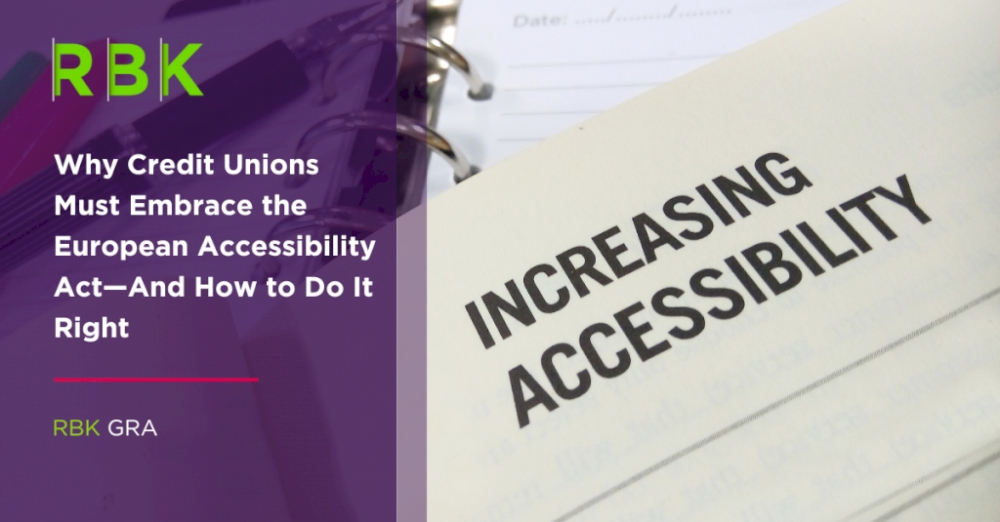The European Accessibility Act (EAA) comes into force on 28 June 2025 and will change how financial services must operate across the European Union. For credit unions, which are built on the principles of community, inclusion and member empowerment, the introduction of this legislation is not just another compliance requirement. Its implementation can be viewed as a unique opportunity to lead the way in accessible, inclusive banking.
This article explores what the EAA means for credit unions, the timeframe for implementation, the consequences of non-compliance, and the strategic benefits of early and meaningful adoption.
What is the European Accessibility Act?
The EAA is EU legislation aimed at improving the daily lives of people with disabilities by making key products and services more accessible across the EU’s internal market. It applies to sectors including banking, retail, transport, and digital services.
The EU Directive will tell “what” needs to be accessible in terms of functional requirements but will not impose detailed technical solutions on “how” to meet accessibility requirements. This means that a certain amount of innovation is possible but in the context of credit unions, the Act mandates accessibility in:
- Banking websites and mobile apps
- ATMs and point-of-sale terminals
- Online and offline customer service
- Contractual information and communication
In essence, anything a member uses to interact with their credit union—physically or digitally—must be accessible to individuals with disabilities.
Why Credit Unions Must Pay Attention
1. Legal Obligation
By 28 June 2025, all covered services and products must be compliant with the accessibility requirements. However, there are transitional arrangements in place which allow any in-scope products and services which were provided prior to the 28 June 2025 to continue to be lawfully used until 28 June 2030. This allows credit unions an appropriate amount of time to update websites, member service kiosks, digital channels etc to meet the legislative requirements.
2. Social Responsibility
Credit unions are built on cooperative values, including equity, social responsibility, and community support. Credit Unions that embrace the changes in ensuring accessibility will not just be compliant with the law but will be living their ESG strategy through improving the lives of their members.
3. Business Opportunity
Around 80 million people in the EU are affected by a disability in some degree. Accessibility is a precondition to ensure their full and equal participation in society. Most member states in the EU have ratified the UN Convention on the Rights of Persons with Disabilities. The legislation creates a single set of requirements and therefore businesses including credit unions will benefit due to the removal of barriers caused by a fragmented approach in this area. The member experience will be enhanced which should in turn create further loyalty for an already strong brand.
Key Areas to be Addressed
1. Digital Accessibility
Credit union websites and mobile applications must meet the Web Content Accessibility Guidelines (WCAG) 2.1 Level AA standards. This includes:
- Screen-reader compatibility
- Keyboard navigation
- Clear contrast and scalable text
- Accessible online forms and transactions
2. Communication and Documentation
Information provided in digital and printed formats (e.g., loan agreements, terms and conditions, account statements, AGM booklets) must be available in alternative formats such as large print, braille, and easy-to-read versions.
3. Physical Accessibility
Self-service banking terminals such as ATMs and self-service kiosks must support:
- Audio output (with headphone jacks)
- Braille keypads or tactile input
- Height and reach accessibility for wheelchair users
4. Staff Training
Employees should be trained to communicate effectively with persons with disabilities, understand assistive technologies, and offer alternative service methods where necessary.
How to Implement
Step 1: Conduct an Accessibility Audit
Start with a comprehensive review of all member touchpoints—
- digital platforms such as the website and mobile app;
- branch infrastructure such as door width, ramps, counter height;
- communication materials and
- member support processes such as call helplines, chatbots, email etc.
Step 2: Develop a Compliance Roadmap
Create a project plan which will ensure compliance by the end of the transition phase. The project plan should include a financial budget to complete upgrades of technology, staff training and content revision but should also allocate appropriate resources in terms of people to ensure that all aspects are covered in time.
Step 3: Collaborate with Experts
Engage and work with accessibility consultants, disability advocacy groups, and IT providers who understand both compliance and the required end user experience. This will ensure that the compliance requirements are met first time.
Step 4: Engage Members
Conduct a member engagement survey specifically targeted at members with disabilities. This will ensure that changes which are implemented meet their needs in a meaningful and effective way.
Step 5: Monitor and Maintain
The implementation of the Act is not a “one and done” task. There will be an ongoing requirement to review and update, and this will need to be part of ongoing ESG initiatives, strategic planning and member engagement into the future.
Conclusion
The European Accessibility Act is a prime opportunity for credit unions to reinforce their member-first philosophy. By proactively adopting accessible practices, credit unions not only ensure compliance but also live up to their mission of inclusion and equity.
Preparation is key and the generous transitional period should be used to work with all stakeholders to look at technology, physical infrastructure, documentation and training to ensure that compliance is achieved by June 2030.
How can RBK help?
If you wish to discuss any aspect of the implementation of EAA within your business, please reach out to our GRA Team.
Disclaimer: While every effort has been made to ensure the accuracy of information within this publication is correct at the time of going to print, RBK do not accept any responsibility for any errors, omissions or misinformation whatsoever in this publication and shall have no liability whatsoever. The information contained in this publication is not intended to be an advice on any particular matter. No reader should act on the basis of any matter contained in this publication without appropriate professional advice.



